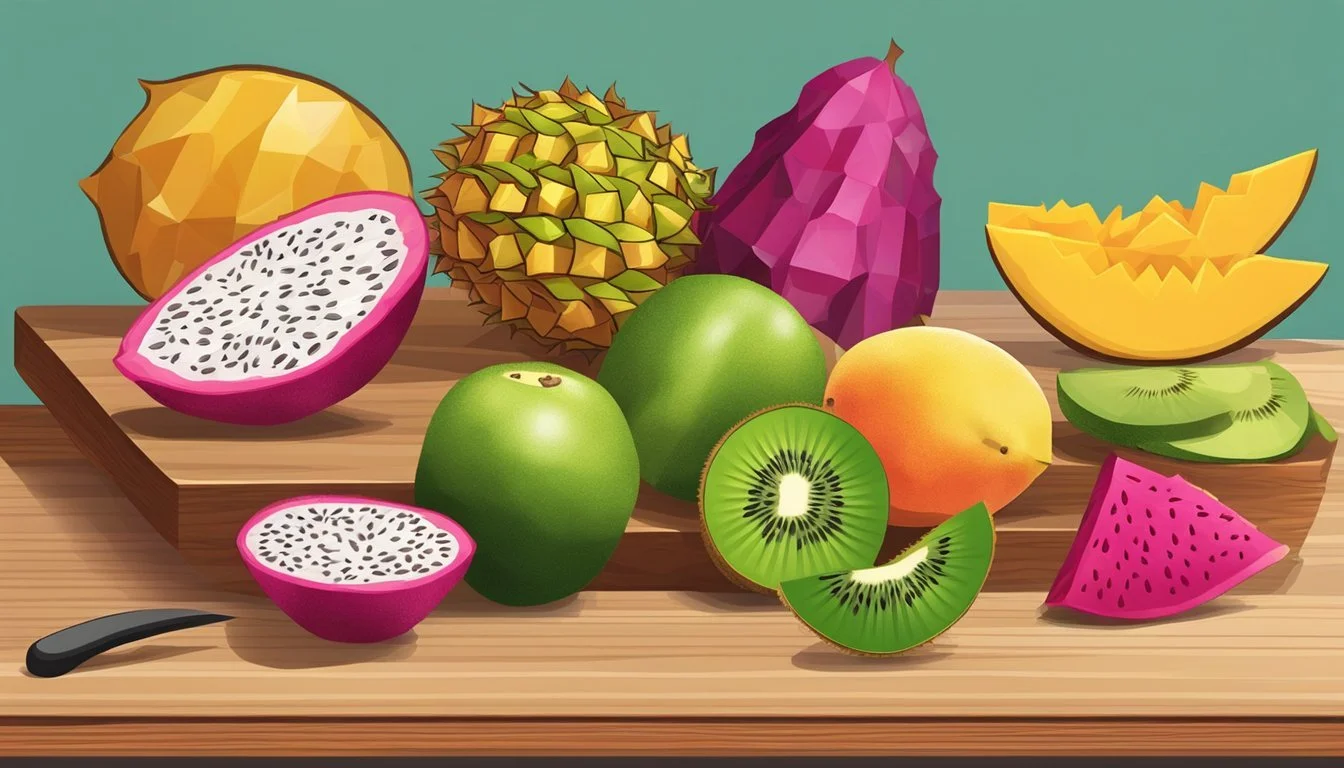How to Choose and Prepare Exotic Fruits
A Practical Guide
Exploring the array of exotic fruits (What wine goes well with fruits?) that our world has to offer can be both exciting and rewarding. Each fruit comes with its unique flavor profile, texture, and nutritional benefits. Choosing the right exotic fruits requires understanding their ripeness indicators and optimal consumption period to ensure the best taste experience.
Preparing these fruits may seem daunting at first, but with proper technique, it becomes a simple task. Whether it is creating a shallow incision to open the thick rind of a mangosteen or enjoying the creamy texture of a ripe cherimoya, knowing how to handle each fruit is key. Integrating them into meals enhances both the nutritional value and the exotic appeal of everyday dishes.
Selecting Exotic Fruits
Choosing the right exotic fruits involves understanding their stage of ripeness and the climates they thrive in. Optimal selection ensures maximum flavor and nutritional benefits.
Assessing Ripeness and Quality
To ascertain ripeness, one must examine the physical attributes of the fruit.
Color: Many fruits change color as they ripen, such as the Mangaba which transitions from green to yellow, and often to red.
Texture: Ripeness often brings a softer texture. For instance, a ripe Custard apple should yield slightly to gentle pressure.
Aroma: Fruits like the Jackfruit develop a more pronounced sweet fragrance when ripe.
Exotic fruits from regions such as Southeast Asia, Africa, India, Indonesia, and Latin America may require specific ripeness indicators. For example, Durian, notable in Southeast Asia, is deemed ripe when its husk begins to crack.
Understanding Origin and Climate
Consider the fruit's native climate, as this influences its ripeness and quality.
Tropical climates like those in Brazil, Hawaii, and the Caribbean produce fruits that are accustomed to year-round warmth and humidity.
Subtropical regions such as parts of California, Peru, and Australia offer fruits that may tolerate cooler temperatures.
Researching the origins helps in setting the right expectations for fruit quality and availability. Fruits such as the Jackfruit from India or Mangaba from Brazil peak at different times of the year due to their native climates.
Health Benefits and Nutritional Facts
Exploring the realm of exotic fruits not only introduces one's palate to new tastes but also provides an array of health benefits. These fruits come packed with essential vitamins and minerals, dietary fiber, and antioxidants that contribute to an individual's overall well-being.
Vitamins and Minerals
Exotic fruits such as dragon fruit, rambutan, and persimmon are treasure troves of nutritional richness.
Dragon Fruit:
Vitamin C: Boosts the immune system.
Iron: Important for blood health.
Rambutan:
Magnesium and Potassium: Aid in maintaining heart health.
Vitamin C, Iron, and Zinc: Crucial for immune function and energy.
Persimmon:
Vitamin A: Supports eye health.
Antioxidants: Protect against oxidative stress.
These fruits not only contribute to better health but are also integral parts of a balanced diet.
Dietary Fiber and Antioxidants
The inclusion of exotic fruits in the diet comes with the advantage of high dietary fiber content, promoting proper digestion and reducing the risk of heart disease.
Fiber: Found in fruits like persimmons, it helps in regulating blood sugar levels and supports healthy digestion.
Antioxidants: Present in many exotic fruits, these compounds are instrumental in combating oxidative stress, which can lead to chronic diseases such as cancer.
For individuals adhering to a vegan diet, exotic fruits offer a variety of nutritional benefits that align with their dietary preferences, providing necessary vitamins and minerals in a plant-based form.
Preparing Exotic Fruits
When preparing exotic fruits, it's important to use techniques that preserve their unique flavors and textures. Proper washing, peeling, de-seeding, and cooking methods are essential to enhance your culinary experience.
Washing and Peeling Methods
When washing exotic fruits, one must ensure they are thoroughly cleansed under running water to remove any surface contaminants. For fruits with edible skins like mangaba, a gentle scrub is advisable. However, for fruits with thicker rinds, like jackfruit, peeling is necessary. A sharp knife should be used to remove the skin, revealing the edible flesh inside.
Cutting and Seed Removal
After washing and peeling, cutting exotic fruits requires precision to retain their distinctive shapes and to ensure that toxic seeds, like those in custard apples, are discarded safely. For instance, jackfruit segments can be sliced into bite-sized pieces, making sure to remove the large, fibrous seeds. For fruits used in desserts or smoothies, cutting into uniform pieces is vital for even cooking and blending.
Cooking Techniques
Exotic fruits lend themselves to various cooking techniques which can amplify their natural sweetness or create complex flavors. Fruits like jackfruit can be baked or boiled and then shredded for use in savory dishes. Roasting can intensify the fruit's flavors, suitable for creating fillings for pies or for incorporating into chocolate confections. Exotic fruits can also be fried for a crunchy texture or pureed for smoothies, jams, and jelly. For a refreshing take, they can be muddled or juiced for cocktails.
Serving Suggestions
When it comes to serving exotic fruits, one can enhance their culinary repertoire with diverse preparations that range from fresh and vibrant salads to indulgent desserts. They offer a versatile flavor profile suitable for breakfast smoothies to evening cocktails.
Salads and Smoothies
Exotic fruits like dragon fruit, star fruit, and jackfruit are excellent additions to salads and smoothies. The freshness and unique flavors of these fruits can be combined to create nutritious and visually appealing dishes.
Salads:
Tropical Fruit Salad: Mix slices of star fruit with other tropical fruits and drizzle with honey-lime dressing.
Jackfruit Salad: Shred the jackfruit and toss it with a medley of greens and a tangy vinaigrette for a vegan delight.
Smoothies:
Dragon Fruit Smoothie: Blend dragon fruit with banana and a splash of coconut milk for a creamy beverage.
Custard Apple Smoothie: Custard apple's creamy texture makes for a rich smoothie base; combine with pineapple and banana for additional sweetness.
Desserts and Baked Goods
Exotic fruits can transform desserts and baked goods into extraordinary treats. Their unique tastes complement both traditional and innovative recipes, infusing them with a hint of the tropics.
Desserts:
Cherimoya Mousse: Puree cherimoya and fold it into whipped cream for a light dessert.
Chocolate-Dipped Star Fruit: Thinly slice star fruit and dip in dark chocolate for an elegant treat.
Baked Goods:
Jackfruit Pies: Use ripe jackfruit as a filling for individual hand pies, spicing the fruit with cinnamon and nutmeg.
Exotic Fruit Jam Tarts: Make a jam from your choice of exotic fruits and use it as a tart filling, topped with light pastry.
Beverages and Cocktails
For those who enjoy experimenting with beverages and cocktails, exotic fruits add a touch of novelty and sophistication.
Beverages:
Star Fruit Juice: Juice star fruit for a refreshing standalone drink or as part of a mixed fruit juice blend.
Exotic Fruit Wine: Ferment fruits like cherimoya into a unique homemade wine.
Cocktails:
Dragon Fruit Margarita: Muddle dragon fruit in a shaker, then add tequila, lime juice, and triple sec for a twist on the classic cocktail.
Custard Apple Pisco Sour: Blend custard apple with pisco, lime juice, and egg whites for a creamy and frothy cocktail.
Incorporating exotic fruits into various servings can not only increase the visual appeal but also enhance the flavor profile of a range of dishes and drinks.
Storage and Preservation
Proper storage and preservation of exotic fruits are essential to maintain their nutritional value and extend their shelf life. The following methods offer effective ways to keep these fruits fresh for both short-term enjoyment and long-term use.
Short-Term Storage Methods
Temperature Control: Most exotic fruits retain their nutritional value best when stored at room temperature until they ripen. Once ripe, they can be transferred to the refrigerator to slow down the aging process, ideally at 40° F or below to prevent spoilage.
Countertop Storage: For fruits like mangos, papayas, and avocados:
Store at room temperature.
Keep away from direct sunlight.
Refrigerator Storage: For ripe fruits or those sensitive to ethylene gas produced by other produce:
Store in perforated plastic bags or breathable containers.
Keep fruits in a separate compartment to avoid cross-contamination with strong-smelling foods.
Long-Term Preservation Techniques
Sugar Syrups: Immersing fruits in sugar syrup can preserve them for an extended period, sweetening them while preventing spoilage.
Preparation:
Dissolve sugar in water to create syrup.
Place fruits in the syrup before sealing in airtight containers.
Ascorbic Acid Treatments: Applying a solution of ascorbic acid, which is Vitamin C, can prevent oxidation and loss of nutritional quality during storage.
Application:
Dissolve ascorbic acid in water according to package instructions.
Soak or spray fruits with the solution before storage.
By applying these storage and preservation methods, one can extend the enjoyment of exotic fruits without sacrificing their flavor or nutritional benefits.
Exotic Fruits of the World
The variety of exotic fruits is vast, offering a delectable palette from different parts of the globe. Here, we explore the tropical regions that thrive with unique fruit varieties and delve into regional specialties.
Tropical Regions and Fruit Varieties
Tropical climates, with their warm temperatures and humid conditions, are ideal for the growth of an array of exotic fruits. Central and South America, Southeast Asia, Africa, and the Caribbean are hotbeds for diverse fruit types. Among these, lychee, with its sweet and fragrant flavor, and mango, known for its rich, pulpy flesh, stand out. Other notable fruits include:
Dragon Fruit: Also called pitaya, recognized by its vibrant skin and speckled flesh.
Jackfruit: This large fruit is celebrated for its sweet taste and meaty texture, often utilized in culinary substitutions for meat.
Durian: Known for its strong aroma and custard-like interior, often referred to as 'the king of fruits'.
Mangosteen: A dark purple fruit with a sweet, tangy, and juicy white interior.
Rambutan: Similar to lychee, rambutan has a hairy exterior and a juicy, lychee-like center.
Regional Favorites and Specialties
Every region has its own specialties when it comes to exotic fruits. The Caribbean offers ackee, a fruit integral to the region's cuisine but must be prepared with care due to its toxic raw seeds. In contrast, the custard apple from South America boasts a creamy texture, tasting like a blend of pineapple and banana. Another South American treat, feijoa or pineapple guava, has a sweet flavor reminiscent of strawberries, pineapples, and guavas. Additional regional fruits include:
Dragonfruit and papaya in Asia, celebrated for their digestive health benefits.
Acai berries (how long do acai berries last?) in the Amazon, valued for their antioxidant properties.
Noni fruit, used for its medicinal qualities across Southeast Asia and Polynesia.
Pomelo from Southeast Asia, with its large citrusy profile that resembles a mild, sweeter grapefruit.



